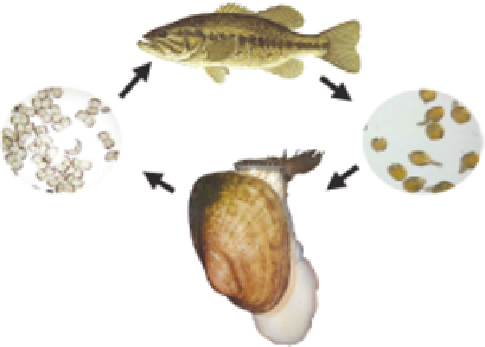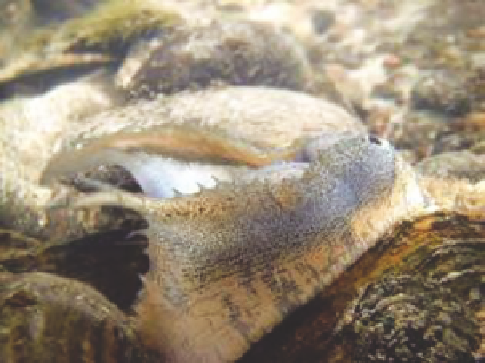Environmental Engineering Reference
In-Depth Information
Fish host
Glochidia
larvae
Juvenile
mussels
Adult
mussel
FIGURE 6.11
Native mussel life history. (From Barnhart, C. and Neves, D., Overview of North American
freshwater mussels, USEPA Mussel Toxicity Testing Workshop, Chicago, IL, 2005.)
FIGURE 6.12
Mantle lap lure of the plain pocketbook (
Lampsilis cardium
)
.
(Photographs by Jeff
Grabarkiewicz and Todd Crail; From Grabarkiewicz, J.D. and Davis, S.W., An introduction to freshwater
mussels as biological indicators, including accounts of interior basin, Cumberlandian, and Atlantic slope spe-
cies, U.S. Environmental Protection Agency, Washington, DC, 2008.)
ability to move, but mortality rates are high. The surviving juveniles become adults in 5-12 years,
and under favorable conditions they can live for 20 or more years, with some species surviving up
to 140 years (McMahon and Bogan 2001; Morales-Chaves 2004). Mussels are commonly used as
biological indicators, since they are sensitive to habitat changes and pollution. Some of the attributes
that make them good biological indicators are (Grabarkiewicz and Davis 2008):
•
Long lived.
•
Sedentary: juvenile and adult mussels move little during their entire lifetime.
•
Burrowers: some species and juveniles burrow deep into the streambed.
•
Filter feeders: mussels obtain food and oxygen from the water column and via interstitial low.
•
Fairly large: mussels contain ample soft tissue for chemical analysis.
•
Spent valves: dead mussels leave a historical record.


Search WWH ::

Custom Search